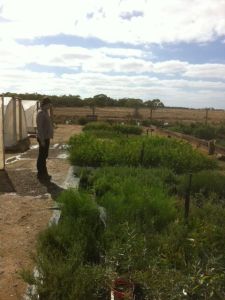
A tough little Eucalyptus porosa – one day soon this entire ex-paddock will be filled with carbon-guzzling natives. Note the plot markers in the background.
I had a great morning today checking out the progress of our carbon-biodiversity planting experiment out at Monarto Zoo. What a fantastic effort! Briony Horner and her team have made some amazing progress.
If you haven’t read about what we’re up to, here’s a brief re-cap:
Late last year we were awarded an Australian Research Council (ARC) Linkage Project grant in which we proposed to examine experimentally the cost-benefit trade-off between biodiversity and carbon using a replicated planting regime. The approach is quite simple, but it will take many years to pay off. What we are asking is: how many different species and in what densities are required to restore a native woodland from an over-grazed paddock that provide the biggest long-term biodiversity and carbon benefits simultaneously for the lowest costs?
Our basic approach is to apply a few biodiversity (native monoculture, medium diversity, high diversity) and planting density treatments (low and high spacing) to plots within blocks repeated across a landscape. We want to test whether the time-consuming and expensive high-density, high-diversity plots end up sequestering more carbon and housing more species once the forest has matured then the other treatments. However, if we can get away with (i.e., end up with the similar carbon sequestration and biodiversity) lower tree densities when planting, and fewer species planted, then our costs will go down.
Briony invited me out this morning to see the progress, and I was blown away! To date we have slashed the grass & weeds, set up and marked out the 80 25 × 25 m experimental plots in 10 blocks, begun digging the reptile pitfall traps, plotted out the bee & invertebrate trapping grids, and taken initial soil cores for carbon analysis. A few photos are included here to demonstrate.
Next week, co-investigator Margie Mayfield is coming down from UQ to help with the baseline biodiversity monitoring. In May, the entire site will be burnt and treated with herbicide to kill the weeds, and then planting begins in June! I can’t wait to see all the plants in the ground.
What was merely an idea only 6 months ago is turning into a fully fledged, 20-ha experiment thanks to Briony and her amazing project management.
Many thanks as well to the ARC, Zoos South Australia, David Chittleborough and his soil team, the South Australia Department of Environment, Water and Natural Resources (DEWNR) and the Australian Flora Foundation for co-investment.







[…] — one in far north Queensland in the tropical rainforests of the Atherton Tablelands, one in the semi-arid Mallee forest of South Australia, and one in the wheatbelt of south-western Western Australia. Here, experimental manipulation of […]
LikeLike
[…] to promote conservation volunteer opportunities, but this is a little different. First, I’m involved in this one, and second, it’s very near to my home. As you might know, the Mount Lofty Ranges area has […]
LikeLike
Hi Corey,
As a student of Environmental Management in Conservation Biology and a passionate lover of Aussie plants, I’m quite interested in this.
I was just wondering at what scale are you measuring fauna biodiversity and how would you prevent or account for the influence of neighbouring plots? What is the separation between plots? Is a 25m x 25m plot large enough to address bird and mammal biodiversity or are you just looking at reptiles/insects etc?
Cheers
Tim
LikeLike
It’s a randomised block design, with no substantial remnant vegetation adjacent to the plots; thus, edge effects are not a concern. We’re focussing on bees and ‘other’ invertebrates from detergent and malaise traps. We also have 0.5 m pitfalls for reptiles. Mammals and birds don’t really come into it because of the scale, although we’ll measure bird use as the canopy develops.
LikeLike